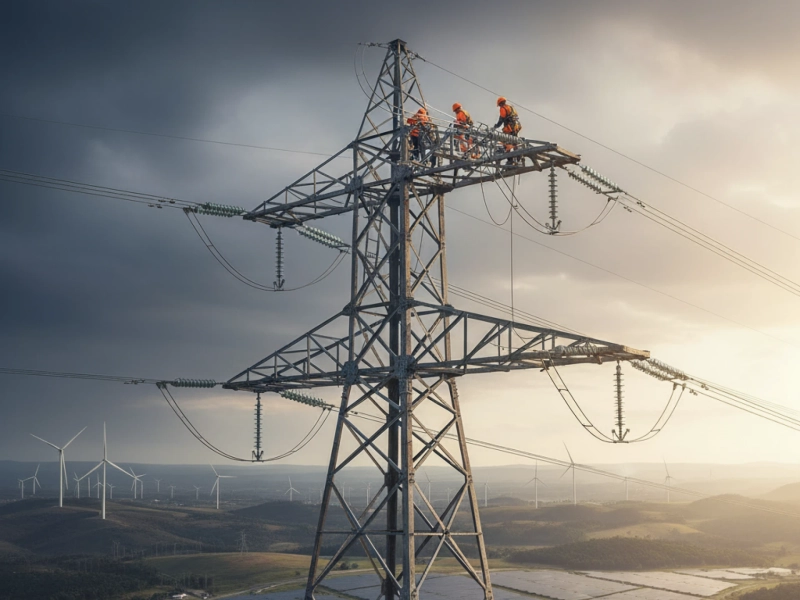The energy transition is accelerating. Electric vehicles, heat pumps, data centers, and the rapid buildout of wind and solar are pushing power demand higher than ever before.
Yet the very backbone of this transformation—the transmission grid—is showing its age.
Building new power lines sounds like the obvious solution, but reality says otherwise: it can take 7–10 years to plan, permit, and build a single high-voltage line, often delayed by local opposition and regulatory hurdles.
That’s where reconductoring steps into the spotlight. It’s not flashy. It doesn’t grab headlines like massive offshore wind farms or sprawling solar parks.
But reconductoring is quietly proving to be one of the most effective tools we have to modernize the grid quickly, affordably, and sustainably.
What Is Reconductoring (and Why Does It Matter Now)?
At its core, reconductoring is simple: it means replacing aging wires on existing transmission towers with advanced, high-performance conductors. Instead of building entirely new lines, utilities can double or even triple the capacity of their grids—without touching a single tower or acquiring new land.
This matters because the U.S. grid alone needs to double transmission capacity by 2035 to meet clean energy and electrification goals, according to the Department of Energy.
Reconductoring allows operators to squeeze more performance out of what already exists, avoiding the red tape of siting new corridors.
Why Building New Lines Isn’t Enough
New transmission projects are essential, but they’re notoriously slow and expensive:
- Time: Average lead time of nearly a decade.
- Cost: Billions of dollars per project, often with legal challenges.
- Opposition: Local resistance to new towers and land use.
Reconductoring sidesteps these issues. Because the towers and rights-of-way already exist, upgrades can happen in months instead of years.
That speed is vital in a decade where electrification and renewables are scaling at a record pace.
The Benefits of Reconductoring
The appeal of reconductoring goes beyond speed. Its benefits stack up across technical, economic, and environmental fronts:
More Capacity, Same Footprint
Modern conductors—made with composite or carbon fiber cores instead of traditional steel—are lighter and stronger. That means they can carry 2–3x the power load without requiring taller or bulkier towers.
Lower Energy Losses
High-performance conductors reduce line losses, meaning less electricity is wasted as heat. Over long distances, this efficiency gain is enormous, saving both energy and money.
Faster Renewable Integration
Solar and wind projects are being built faster than transmission can keep up. Reconductoring creates headroom on existing lines, ensuring renewables don’t sit idle waiting for interconnection.
Cost-Effective Modernization
Utilities can avoid the capital costs of new steel, land, and construction. Reconductoring projects typically cost 30–50% less than new builds.
Climate and Environmental Gains
By reusing existing infrastructure, reconductoring minimizes disruption to communities and ecosystems. Less concrete, less steel, and fewer land-use conflicts mean a smaller carbon footprint.
Grid Reliability Under Stress
New conductor materials handle extreme heat and sagging better, making them more resilient to the climate-driven stresses of modern power systems.
Real-World Examples of Reconductoring in Action
Reconductoring is not a theoretical solution—it’s already happening.
- United States: The DOE has identified reconductoring as a “no-regrets” strategy to expand capacity quickly, and utilities in states like California and New York are already implementing projects.
- Europe: Countries such as Germany and the UK are using reconductoring to meet their 2030 renewable targets without waiting for new mega-lines.
- India and Brazil: Fast-growing economies are leaning on reconductoring to balance surging demand and integrate large-scale solar and hydro projects.
These examples demonstrate the versatility of reconductoring—it works in both mature and developing grids.
The Policy Dimension: Why Policymakers Should Care
For policymakers, reconductoring represents low-hanging fruit. Supporting it through funding, incentives, and streamlined regulation could unlock massive grid benefits in the short term. Some priorities include:
- Incentivizing utilities to adopt advanced conductors.
- Streamlining approval processes for reconductoring projects.
- Integrating reconductoring into national energy security strategies.
- Funding research and deployment of next-generation conductor technologies.
In the race to modernize the grid, reconductoring is not just a technical solution—it’s a policy lever.
Looking Ahead: The Grid’s Hidden Hero
The future of reconductoring is even brighter. Emerging materials, such as nanocomposite conductors, promise even greater efficiency. As nations aim for net-zero, reconductoring offers a scalable, pragmatic way to modernize grids without starting from scratch.
It’s a hidden hero because it works behind the scenes. Consumers won’t see new towers stretching across landscapes. But they will feel the impact—in fewer blackouts, more renewable power, and a faster clean energy transition.
Conclusion
The clean energy transition is often framed around shiny new technologies: EVs, wind turbines, and hydrogen hubs. But none of them can thrive without a stronger grid. Reconductoring ensures that the wires we already have can rise to the occasion.
It’s faster, cheaper, greener, and already proven. In a world where time is the scarcest resource in the climate fight, reconductoring may just be the quiet revolution we need most.
Frequently Asked Questions
Q. What is reconductoring in power grids?
A. Reconductoring means replacing existing transmission wires with high-performance conductors to increase capacity without new towers.
Q. How does reconductoring improve grid reliability?
A. New conductors resist sagging, handle heat better, and reduce line losses, making grids more resilient.
Q. Is reconductoring cheaper than building new lines?
A. Yes. Reconductoring typically costs 30–50% less than new transmission builds.
Q. How soon can reconductoring projects be deployed?
A. Many projects can be completed in months, compared to years for new lines.
Q. What role does reconductoring play in the clean energy transition?
A. It enables faster renewable integration, expands grid capacity, and reduces carbon impacts by reusing existing infrastructure.



